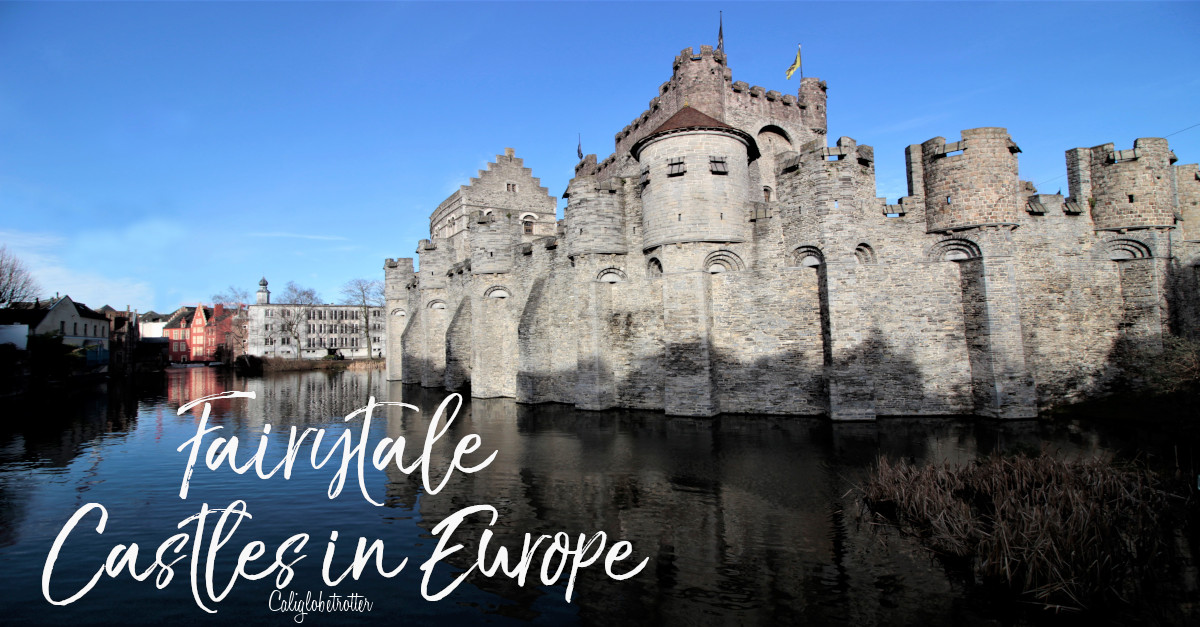
Disclaimer: This post contains affiliate links. If you click on one and make a purchase, I might make a little extra spending money, at no extra cost to you. As always, all opinions are my own and these products/services have been found useful during our travels and come highly recommended to you from yours truly!
When you think of Europe, you automatically think of its romantic, whimsical castles, perched high on a hill overlooking a picturesque town below. It’s hard to imagine a time when it was normal for royalty to walk these palaces, surrounded in gilded hallways and gold, stuccoed ballrooms. It’s also fascinating to wonder what they might think today to see thousands of tourists every day walking through their homes. But nonetheless, the average girl can finally experience what it’s like to be a princess, if only for a few hours in some of Europe’s most beautiful castles!
Love European Castles? PIN IT FOR LATER!!

King Ludwig II of Bavaria’s Romantic Castles
3 Transylvanian Fantasy Castles in Romania
It would be an understatement if I said that Europe has NO SHORTAGE of castles and palaces. They’re EVERYWHERE! You’re probably wondering how many castles are in Germany? There are over 20,000 castles while France has 6,500 castles, if not more!! Even if it doesn’t even remotely look like a castle, it most likely is! But what’s the difference between a Castle and a Palace?
The word ‘castle’ derives from the Latin word meaning ‘fort’, so in essence, a castle is a fortified dwelling, so in German speaking countries, many castles are call “Burg”. These fortifications were used for defense, whereas a castle implies that is used as a residence. Top aristocrats such as a lord, knight or even a monarch would typically live in such castles during Medieval times.
The term ‘palace’ comes from Rome’s Palatine Hill, where the wealthy built their luxurious homes during ancient Roman times. Palaces are, therefore, not built for defense but rather, comfort and are typically much more elegant. In German speaking countries, these are referred to as a “Schloss”.
Books of European Royals to Read Before Coming to Europe
If you’ve been following me for a while now, then you know I’m a HUGE fan of Historical Royal Fiction! I love to read books of European royals, especially before traveling to a country known for fascinating royals and castles. So, scattered throughout this post, you’ll find some of my favorite historical Royal novels you should definitely read before coming to Europe!
Bled Castle // Slovenia
Set in one of the most romantic places in Europe, overlooking one of Europe’s most beautiful lakes, the Bled Castle dates back to 1004, making it one of the oldest castles in Europe! Perched on a hilltop cliff, you can hike 10-20 minutes up to the castle and explore the castle’s blacksmith’s shop, a printing press and a honey store. You’ll also find the Castle Chapel which dates back to the 16th century. Views from the castle over Lake Bled are equally as stunning making for a wonderful day trip from Ljubljana.

Bratislava Castle // Slovakia
Located on a hill overlooking the city of Bratislava below, with the Danube River at its base, the Bratislava Castle is a stronghold that dates back to 907. Today the castle houses the Slovak National Museum but at one time, it held the Hungarian Crown Jewels. The Baroque gardens in the back were designed by the Empress of Austria, Maria-Theresa when the country was still under the Austro-Hungarian empire, prior to WWI. Today, it’s one of the main sights to see in Bratialava, though it’s hard to miss!

Bran Castle // Romania
Blood sucking bats and threatening skies are often associated with Bran Castle, one of the most mysterious castles in Transylvania, home to the mythical Count DRACula, the iconic lead character of Bram Stoker’s Dracula. Though what may have inspired this spooky story is the real life Vlad the Impaler, Romania’s most infamous Prince, known for impaling his foes. So you might want to carry some garlic cloves in your pockets to ward off any unwanted foes that may be lurking, however, you’ll be interested to know that the castle was built between 1438-1442 once the Saxons of Kronstadt (Brasov) were given permission to build a defensive castle here.

Buckingham Palace // England
Though not exactly one of the most fairytale castles in Europe, Buckingham Palace is home to the Queen of England, Elizabeth II. Built by the Duke of Buckhingham in the 16th century, Queen Victoria would be the first monarch to occupy the palace shortly after her coronation in 1837. Tourists flock to Buckingham Palace not only in the hopes of catching a glimpse of the Queen, but also to watch the performance known as “Changing of the Guards”, the Queen’s Royal guards and is therefore, easily one of the most popular tourist sights to see in London.
 |

Buda Castle // Hungary
The Buda Castle, also referred to as the Royal Castle, is easily one of the largest castles in Europe. Completed in 1265, the massive Baroque castle which was once the home of Hungarian kings in Budapest is now home to the Hungarian National Gallery and the Budapest History Museum. Sitting atop the southern tip of Castle Hill, the castle can be reached by the Castle Hill Funicular. Much of the furniture within disappeared after the Siege of Budapest in 1945 and much of the castle destroyed in the battle. Under the Communist regime, it became Europe’s biggest renovation project.

Burg Eltz // Germany
Today, one of the most Insta-popular castles, Burg Eltz is located deep in the hills of the Moselle Valley, between Koblenz and Trier. It was built jointly among three heirs, in what is known as a Ganerbenburg. Within this single castle, 33 generations of 3 branches of family have resided in this castle, each with their own section and therefore, only small portions of this German castle are open to the public.

Burg Hohenzollern // Germany
Located atop a mountain in the Schwäbisch Alb, Burg Hohenzollern was first built in the 11th century as a fortress and throughout its turbulent history had been destroyed and rebuilt multiple times. It would be rebuilt a third time, in its current appearance, as a family memorial for Hohenzollern by King Frederick William IV of Prussia, adding a touch of the Loire Valley’s romanticism influence and today the castle is one of the best castles in Germany to visit!

Cesky Krumlov Castle // Czech Republic
An easy day trip from Prague, Cesky Krumlov is a medieval town nearly forgotten about until the 90s. Perched above the town is a massive conglomeration of 40 buildings, making up what is the Krumlov Castle. One of the main sights to see at the Krumlov Castle is the Baroque Castle Theater which is one of the best preserved in Europe. The main eye catcher of the castle is the pastel colored Castle Tower, often nicknamed the “Wedding Cake Tower”, which offers stunning views over the entire town.

Chateau du Haut-Koenigsbourg // France
One of the main sights to see on the Alsace Wine Route, the Château du Haut-Kœnigsbourg, is perched up high in the Vosges Mountains, near the town of Kintzheim and Saint-Hippolyte. The castle was largely destroyed during the Thiry Years’ War and left in a pile of rubble for nearly 200 years before the German Emperor Wilhelm II insisted it be rebuilt stone for stone. Between 1900-1908, the castle used the most modern technology of the time to rebuild the castle and remained in German hands until after the First World War.

Corvin Castle (Hunedoara Castle) // Romania
Located in the rather run-down industrial town of Hunedoara, Corvin Castle is Romania’s greatest fortress and medieval castle! It often tops the list of both spookiest buildings in the world AND one of the most fairy-tale like castles. Contradicting, but even villains have to live somewhere, right?
Built in a traditional Gothic style, the castle has high rising turrets, medieval weaponry on display and some dark history including a torture chamber, the castle was built in 1446, it wouldn’t be completed until 1480.

Edinburgh Castle // Scotland
Perched upon Castle Rock, the Edinburgh Castle is a UNESCO World Heritage site as it has been inhabited since 2AD! Since then, the castle has had a turbulent history compromising of 26 different sieges, most notably during the Wars of Scottish Independence. While from below it sits cozily above the city center, it now houses the Scottish Crown Jewels, once thought lost. As the focal point of Edinburgh, it also plays a big role throughout the August festivals in Edinburgh, used as the backdrop for the Edinburgh Military Tattoo, as well as the Edinburgh International Festival.

Eilean Donan Castle // Scotland
Unquestionably Scotland’s most famous castle, Eilean Donan Castle dates back to the 13th century and was a stronghold for the Clan Mackenzie and Clan MacRae until it was practically destroyed in 1719 during the Jacobite rebellions. Falling into ruin after the clans dissolved following the Battle of Culloden, it wouldn’t be rebuilt until the 20th century, following the original layout plans to an exact T, except with the addition of the arched bridge.

Hluboka Castle // Czech Republic
Just a 10 minute drive from the relatively unheard of town of České Budějovice, the Hluboká Castle is one of the most beautiful castles in the Czech Republic. Built in the 13th century, it would be remodeled several times over the next centuries, modeling the castle in an English Neo-Gothic style resembling England’s Windsor Castle. The castle was inhabited by the Schwarzenberg family up until 1939 before emigrating to escape the Nazis.

Heidelberg Castle // Germany
Perched midway up the Königsstuhl mountain side, the Heidelberg Castle is one of the best castle ruins in Germany adding a touch of romanticism in this already incredibly picturesque town. The castle has had a string of bad luck from being struck by lightning twice and being destroyed by the French in the 17th century before the castle was finally abandoned. Today, the castle houses the German Pharmacy Museum containing a collection of 18th and 19th century pharmacy stores, as well as housing the world’s largest wine cask!

Herrenchiemsee Palace // Germany
As one of the best day trips from Munich, the Herrenchiemsee Palace is only reachable by boat as the palace is located on the island of Herrninsel on Lake Chiemsee. It is a replica of the Palace of Versailles in Paris, built to honor the Sun King by Bavaria’s King Ludwig II, the same crazy King who built Germany’s most famous castle, Schloss Neuschwanstein. Like Schloss Neuschwanstein, the castle was never completed before his untimely death in 1886, and therefore is only a fraction of the size of the original, though equally as stunning. The Bavarian Versailles even has its very own Great Hall of Mirrors.

Het Gravensteen // Belgium
As the main sight to see in Ghent, the Gravensteen Castle wows all visitors right from the get go. Located directly in the center of the historic city center and surrounded by a moat, and though it might have 24 Disney-esque turrets, it houses a very un-Disney-eqsue museum on medieval torture instruments. The Castle of the Counts., though the current castle dates back to 1180, its history dates farther back than that and during its life time has served as a court, a prison, mint and cotton factory before becoming a museum and main attraction. Without a doubt, one of the best castles in Belgium.

Hofburg Palace // Austria
Located in the heart of Vienna’s historic city center, the Hofburg Palace was the former imperial palace of the Emperor of the Austro-Hungarian Empire until the end of WWI. It was used by Austrian royals as their winter palace and seat of government since 1279 while the Schönbrunn Palace was used as their summer residence. Of interest here is the Imperial Silver, as well as the Austrian Crown Jewels and finally, the former rooms of Empress Elisabeth aka “Sisi”.
 |  |

Hohenschwangau Castle // Germany
Though often overlooked for its grander and more famous neighboring castle, the Hohenschwangau Castle in Schwangau is still worth a peak, if only for the stunning views it offers of Schloss Neuschwanstein. However, historically, the castle dates back to the 12th century before falling into ruins by the 19th century. It would later become the summer residence of King Maximilian I Joseph of Bavaria. King Ludwig II would spend many summers here as a child, using it as a hunting lodge and would later be inspired to build his famous Schloss Neuschwanstein just opposite this tiny town.

Lichtenstein Castle // Germany
Not to be confused with the country of LiEchtenstein, the Lichtenstein Castle is informally known as “the Little Brother to Neuschwanstein”. This fairy tale-like castle is built into the cliff, just above the town of Honau. Younger than it appears, the castle you see today was rebuilt and redesigned based on the novel Lichtenstein written by Wilhelm Hauff in 1840, though a castle has been here since 1200. What could be more fairy-tale like than a Disney-esque castle with a wooden bridge and tower?

Linderhof Palace // Germany
The only castle of three built by “Mad” King Ludwig II of Bavaria to be completed during his lifetime before his unexpected death, Linderhof Palace is also by far one of the most extravagant of the three. Located not far from Oberammergau in the Bavarian Alps, King Ludwig II lived a hermit-like lifestyle here for the last eight years of his life and once again you can see many influences to France’s “Sun King” King Louis XIV while the palace grounds are some of the most stunning. One of the most interesting sights to see at Linderhof Palace is the famous Venice Grotto.

Malbork Castle // Poland
As an easy day trip from Gdańsk, Malbork Castle is one of the most significant castles in Poland, as well as one of the most famous in Eastern Europe. Located right on the shores of River Nogat, Malbork Castle dates back to the 13th century by the Teutonic Knights and is therefore, one of the best representations of medieval architecture, as well as one of the largest brick castles in the world! Shortly before World War II, the castle was restored only to be destroyed again during the war. It would remain largely neglected until 2016 when it finally underwent its final restoration.

Miramare Castle // Italy
Just a mere ten minute drive from Trieste, along the Adriatic Sea, the Miramare Castle is a heavenly white stone castle perched on a cliff just feet above the deep blue sea below. And while it may look lovely, its steeped in a dark legend that he who may stay the night here, may fall prey to an untimely death. Commissioned by Austria’s Archduke Ferdinand Maximilian of Hapsburg for his beautiful wife in 1856 as a retreat from the Hapsburg Court, this idyllic slice of heaven was built for a queen, surrounded by 22 acres of gardens and forests.

Munich Residenz // Germany
Located directly in the center of Munich‘s historic city center, the Munich Residenz, though it may look like a conglomeration of buildings, is actually a pleasant surprise inside. Opulence doesn’t even begin to describe the royal residence of the Wittelsbach family. Chandeliers, luxurious furniture and drapes bedeck all 100 rooms of this castle built in 1385! Today, it no longer functions as a seat of government but instead as one of the main tourist attractions in Munich. Main sights to see at this massive palace include the Cuvilliés Theatre, the Treasury Museum as well as the Antiquarium.

Neuschwanstein Castle // Germany
Without a doubt, Germany’s most popular castle, Schloss Neuschwanstein is the epitome of Disney-esque romanticism. Often referred to as the “Disney Castle”, it was used as inspiration for Walt Disney’s castle, though it is far more fascinating than that. Built by “Mad” King Ludwig II of Bavaria, the castle would not be completed before his untimely death, therefore, only a whopping 14 of the 360 rooms are complete, yet those that are finished are some of the most extravagant. Built in honor of the composer, Richard Wagner, the castle is perched just opposite Schloss Hohenschwangau.

Nuremberg Castle // Germany
A collection of medieval fortified buildings overlooking the historic city center below, the Nuremberg Castle comprises three sections, the Imperial castle, the former Burgraves’ castle and a collection of buildings built by the Imperial city. It’s considered to be one of Europe’s most formidable medieval fortifications, signaling the important role it played in the Holy Roman Empire. Today, from a distance, the castle is an impressive collection of turreted towers of pretty pink sandstone with a mix of romantic half-timbered frame buildings.
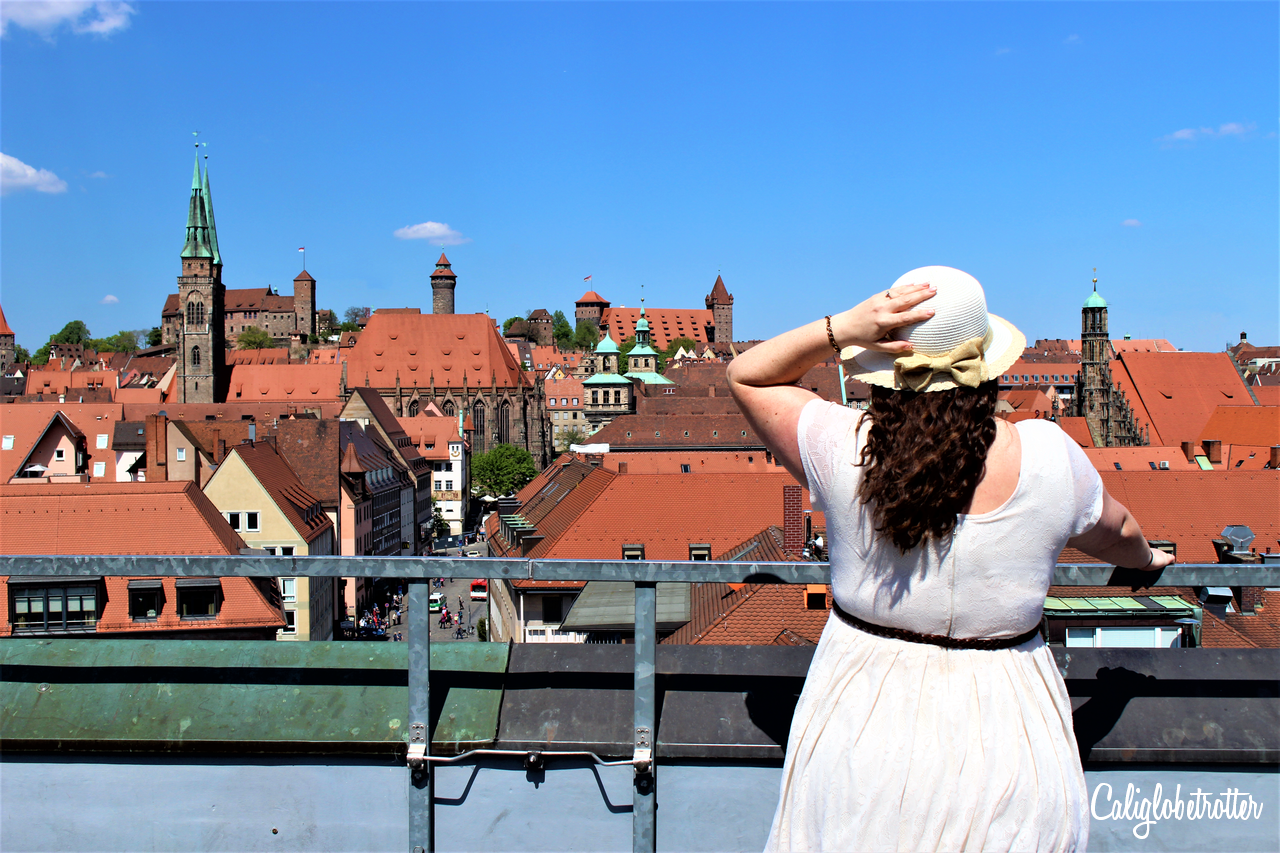
Nymphenburg Palace // Germany
Located on the outskirts of Munich, Nymphenburg Palace was built as a summer residence for the Wittelsbach family, while the Munich Residenz was their winter palace. The palace was expanded and extended multiple times to include a variety of buildings, pavilions and outdoor gardens in a typical French style, it is today a popular day outing for many locals. With a tour of the interior, you’ll catch a glimpse of the luxurious lifestyle of Bavarian royalty with the Grand Hall being the focal point of the entire palace.

Peles Castle // Romania
Not far from the Sinaia Monastery in the Carpathian Mountains is Peleș Castle, the most famous castle in Romania, inspired by Bavarian castles. Built by Carol I, the first Romanian King in 1875-83 with his own funds, his wife Elisabeth of Wied, having grown up in Germany had a massive influence on designing this castle. Architects, designers, stone masons and carpenters were brought in from all around Europe to help design the castle. The castle was closed to the public for nearly two decades under the Communist regime following the abdication of King Michael I in 1947 but was quickly reopened to the public following the collapse of the Communist regime and is thus one of the best day trips from Bucharest.

Prague Castle // Czech Republic
Built in the 9th century, the Prague Castle is a conglomeration of multiple buildings, making it the largest ancient castle in the world according the Guinness Book of Records. Once the seat of power for the kings of Bohemia, Holy Roman emperors and presidents of the former Czechoslovakia, today, it houses the Bohemian Crown Jewels and is one of Prague’s main attractions, as well as the Gothic St. Vitus Cathedral located in the heart of the castle grounds.

Reichsburg Castle // Germany
Perched above the picturesque half-timbered town of Cochem, on the left bank of the Mosel River, the Reichsburg Castle is one of the most popular sights to see in the Mosel Valley. The castle dates back to the 12th century, though the castle you see today would be rebuilt to its former Romanesque beauty 180 years after it fell into ruin in 1689. Best of all, if you’re looking for a kid-friendly adventure in Germany, then be sure to stop by every Friday and Saturday for a Knight’s meal!

The Royal Pavilion // Brighton, England
As one of England’s best seaside town, the Royal Pavilion is an added bonus to this Victorian era style town! Though upon first glance, you might not assume that this castle belongs in England but rather India. George IV expanded it over three stages, taking the simple farmhouse and turning it into the lavish royal residence designed in the Indo-Saracenic style which was popular in the 19th century. The Pavilion was a discreet location for the then Prince of Wales to enjoy his secret liaisons with Maria Fitzherbert, whom he would secretly marry. Today though, the Royal Pavilion is one of the best castles to visit in England.

Schonbrunn Palace // Austria
Just slightly outside of Vienna’s historic city center, Schönbrunn Palace was the summer residence of the Habsburg rulers up until World War I. Completed in 1744-49 under Austria’s beloved Empress Maria-Theresa, the Rococo palace has a whopping 1,441 rooms, each elegantly decorated. Today, the palace is one of the main sights to see in Vienna, as well as the palace’s extensive and beautifully decorated gardens which make for a pleasant stroll through.

Tower of London // England
Located directly next to the Tower Bridge in the heart of London, the Tower of London was first built as a fortress in 1066 by William the Conqueror. This imposing castle has played a major role in English history, serving first as a fortress, then as a royal residence, an armory, a prison which even housed Queen Elizabeth I prior to her reign, as well as the Royal Mint, a site of execution and today now houses the Royal Crown Jewels. Today, it’s one of the best sights to see in London, though it’s recommended to get there early!

Wartburg Castle // Germany
Another hilltop castle, Wartburg Castle is one of the most important castles in Germany, and is so important that it was the first German castle to receive a UNESCO World Heritage status. The castle would be built upon this particular mountain top based on the story that Ludwig der Springer discovered the land following a hunt. Perched above the small town of Eisenach, the castle would be play a vital role during the reformation as Martin Luther, the Protestant reformer, would seek refuge here as he translated the New Testament from Greek into every day German while in incognito.

Overall, you can say that this is only a FRACTION of the beautiful castles in Europe! I’ve seen more castles in my lifetime than simply what’s in this post, but I love each one almost as equally as the next as each one is so different and unique, each with a fascinating history. And even with all the amazing castles and palaces in Europe, there are even more stately houses, such as Chatsworth House, which easily rivals any castle.
Nonetheless, visiting castles in Europe is by far one of the best things to do in Europe, after all! There is no shortage of castles, and there’s always one around the corner! There are entire regions scattered in castles, for example, the Loire Valley has some of the most fairytale-esque castles in Europe and in Germany, there are a plethora of castles in the Rhine Valley, though many are simply beautiful castle ruins today.
If you’re looking to visit Europe’s Castles, I highly suggest buying any of the following travel guides which I have personally used to help you navigate through this beautiful country! These are my travel bibles!
 |  |  |  |
Disclaimer: This post contains affiliate links. If you click on one and make a purchase, I might make a little extra spending money, at no extra cost to you. As always, all opinions are my own and these products/services have been found useful during our travels and come highly recommended to you from yours truly!
Other Related Posts:
The ULTIMATE List of Day Trips from Munich
The BEST Day Trips from Frankfurt
Picturesque Half-timbered Towns in Germany
50+ STUPID PRETTY Towns in Europe
Liked this post? PIN IT FOR LATER!!
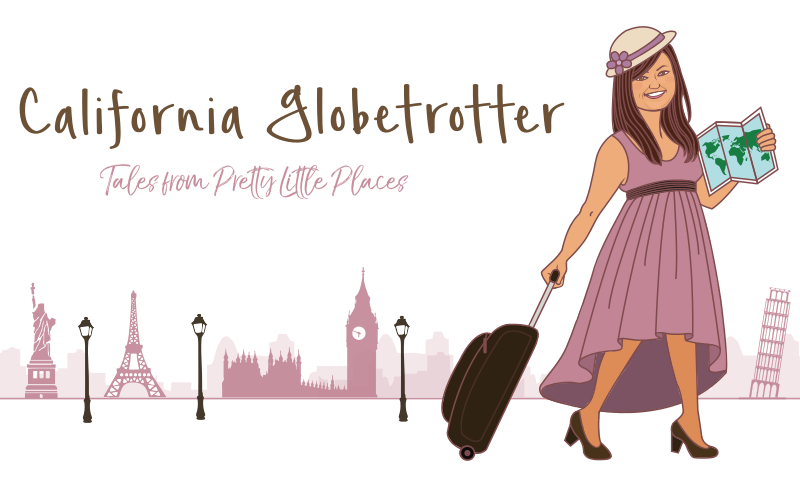
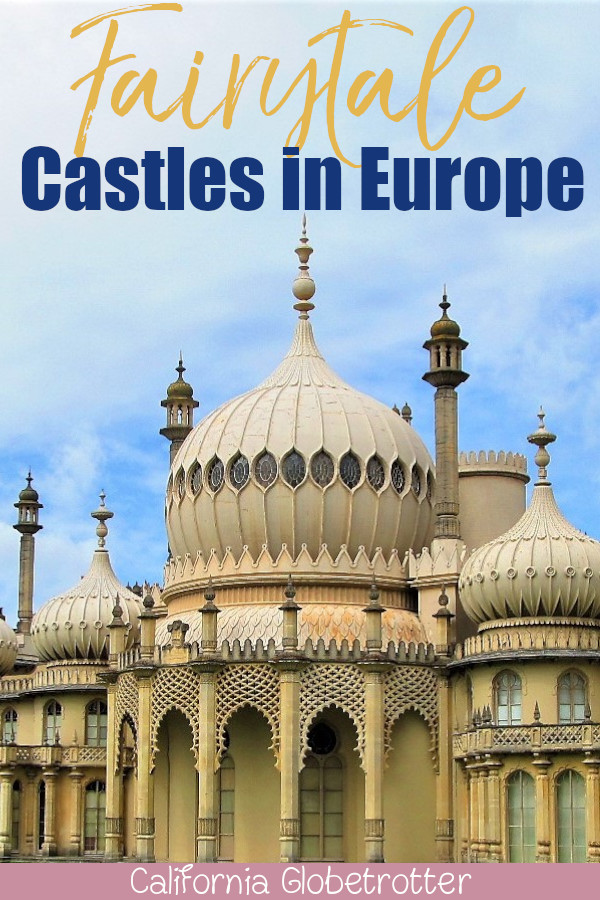
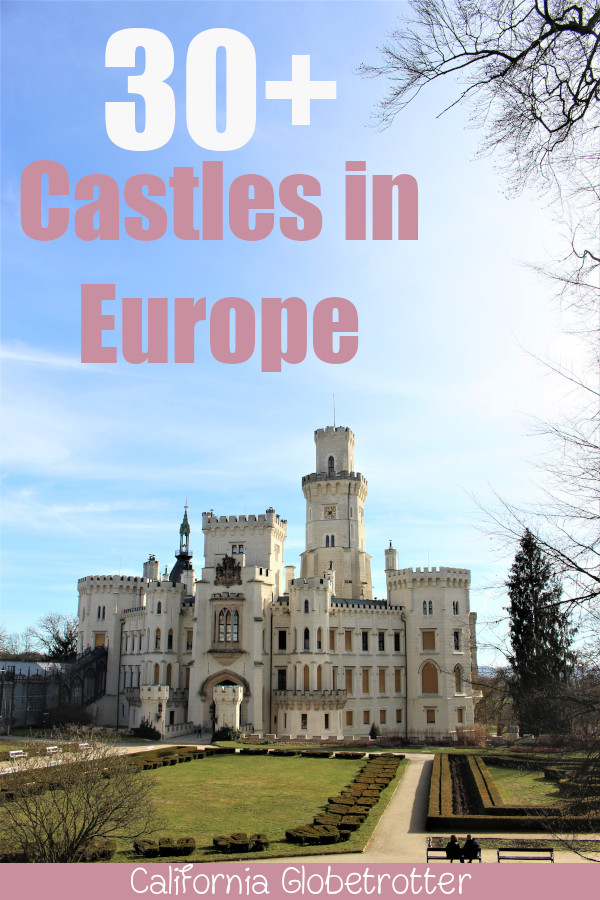



many wonderful castles, I’m glad I’ve visited some of these:) but all they all really castles, I mean isn’t there a distinction between a castle, a fortress and a palace?:)
As I wrote in the introduction, a fortress was built for protection, which is also known as a castle. A palace is a place of luxury, art and sophistication.
Wow what a great guide and collection of castles and palaces! Im surprised how many we’ve seen! Our favourite was going inside Buckingham Palace and seeing all the ornate royal rooms! We’re hoping to go inside the Brighton Pavilion next time we’re visiting as we’ve only seen it from the outside in the grounds.
I’ve been inside both of those and they are truly stunning! I highly recommend a tour of the the Royal Pavilion!
We love visiting castles. We’ve seen lots in England and Wales but would love to visit some of the castles you’ve written about in Germany and Romania. It’s great to see them all together in a post like this. Thanks so much for sharing it with us on #farawayfiles
What a fantastic regal guide, and so many wonderful options. I’m ashamed to say I have never made it to the Brighton Pavilion – a MUST this year. #farawayfiles
This is a great collection of castles throughout Europe. I have been to only a small number of them. I am impressed by the varied styles and, in particular, the Royal Pavilion in Brighton.
A great list. I’ve been to many of them but none of the German ones. Can I suggest an addition? St Michael’s Mount in Cornwall, England is a great castle on a fabulous island setting. Worth a visit! #farawayfiles
I’ve been dying to go there for years and our next visit to England will include that region!
These are stunning – we’ve visited a few, but not the majority….. have ideas of doing a cycle ride along the Rhine in the future, so may look to see if we can visit some along the way. #farawayfiles
That’s actually quite popular and we even talked about doing it! Though I would get distracted with all the wine!! ?
What a fab idea for a post, pinning this for future reference #FarawayFiles